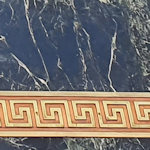
One of Vienna’s attractions is the city’s particular brand of Art Nouveau design known as Jugendstil.
Jugendstil buildings, for example, and other innovative architecture of the late 19th and early 20th century appear throughout the city. Fortunately, the popular tourist areas in the centre also include a few lovely examples.
- See also:
Mosaics and modernism
I’ve picked out some of the interesting turn-of-the-century housing and business premises around the largely pedestrianised locations centered on the long Graben street at the heart of Vienna.
Of course, the rest of the centre has plenty of further examples, such as the Ankeruhr or Postsparkassenamt, but these suggestions cover a compact area and mimic where you’re probably walking anyway (at least on your first trip to Vienna).
Bognergasse
Our journey starts with two business premises on Bognergasse at the western end of the Graben.

(Not your average-looking pharmacy)
The ground floor pharmacy at Bognergasse 9 with its twin Jugendstil angel mosaics grabs all the attention on this 1901 building by Oskar Laske, who subsequently worked as a war artist in WWI.
The Engel Apotheke (actually the Zum weißen Engel pharmacy) looks back on an unfathomably long history that possibly began in the mid-15th century.

(A popular gastronomic location today)
The site at Bognergasse 5 also dates back centuries but the current building “only” to the very start of the 1900s.
The main point of interest is the restaurant, wine merchant and delicatessen Zum Schwarzen Kameel, first established in 1618. Put your head through the door to see the refined Jugendstil interior originally designed by Robert Oerley, who became a leading light in the Wiener Secession.
Kohlmarkt
Bognergasse emerges onto one end of the Graben, but before we go down that street, a quick detour up Kohlmarkt in the direction of the Hofburg palace (decidedly not Jugendstil).
Two designs toward the end of Kohlmarkt by Adolf Loos, one of the mainstays of the Wiener Moderne, deserve your particular attention.
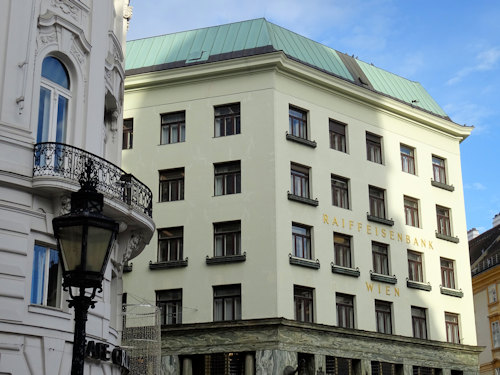
(The Loos House that set Viennese tongues wagging)
The notorious 1912 Loos House allegedly so offended the Kaiser with its lack of decoration that he ordered the windows looking down on it from his palace to be shuttered up.
The post-Jugendstil design helped usher in the era of modern architecture. The building certainly stands in contrast to its more historical surrounds.
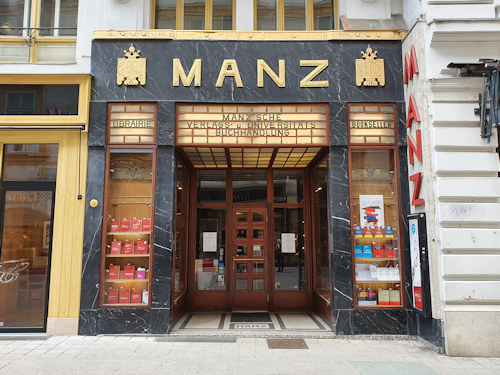
(Still a thriving specialist bookstore)
Loos gave the Manz bookshop at Kohlmarkt 16 a black marble 1912 portal entrance with a welcoming illuminated alcove. The darker serious tone seems to reflect the focus of the publisher and shop within; Manz specialises in law, taxation and economics (not a store for the faint hearted).
Elsewhere on Kohlmarkt, the building at No.1 (from 1896) shows Jugendstil elements beginning to encroach on historicism design, as evidenced by the gold decoration on the horizontal green supports.

(Kohlmarkt 2)
Even though architect Friedrich Schön was known for relatively conservative designs, the 1909 house opposite at No.2 takes a more modern approach. It impresses particularly with its ever-diminishing window sizes, almost as if following some mathematical progression. Sadly, the Nazis murdered Schön in 1941.
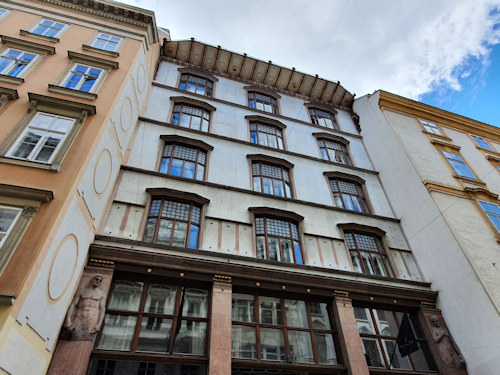
(Kohlmarkt 9)
The house at No. 9 (from 1900) uses a bay window effect to add a distinctive touch above the columned ground floor. Architect Max Fabiani also designed the well-known Urania building in the northeast corner of the city centre.
The previous building here played host to a rather famous guest: the composer Chopin lived there in the early 1830s.
Now wander up the Graben…
The Graben
Immediately on your right as you enter the Graben from Kohlmarkt is house No. 17 from around 1905; its predecessor allegedly claimed Mozart among its occupants. The building suffers a little in comparison with its neighbour…

(The decorative mosaics at No.16)
Built at the end of the first decade of the 20th century, No.16 still possesses its remarkable mosaics, albeit rather high up on the façade. I rather like the dark railings and projecting windows, too.
The other side of the street from No.16 and No.17 features a particularly iconic piece of Jugendstil architecture. Not a building as such, but a pair of underground public toilets (the only ones of their kind in Vienna).
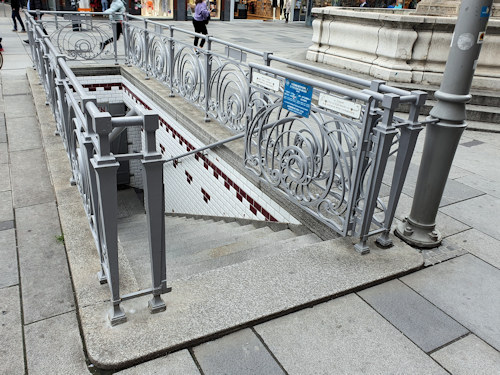
(I chose not to take a photo of the interior of the toilets, because I was already getting funny looks from users.)
Adolf Loos continues his march through the city centre at Graben 13, where he designed the interior and portal for the gentleman’s tailors Knize (another entrance making use of black marble).
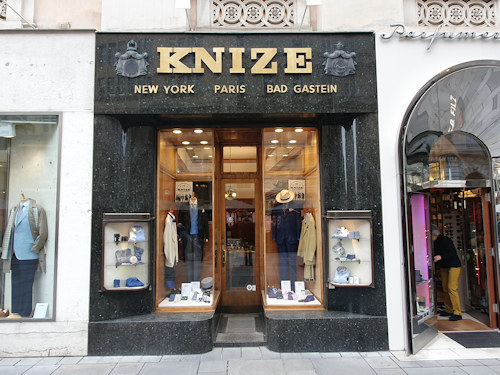
(Another Loos design)
Still going strong today, Knize’s former customers include Emperor Franz Joseph, Oskar Kokoschka, Marilyn Monroe, and Marlene Dietrich! (Which also sounds like an intriguing dinner party guest list.)
We complete our look down the Graben with the ground floor premises at No.8, notable for their white-veined black marble and the gorgeous brass fittings around the bay windows (the bird’s feet design remains a popular photo motif).
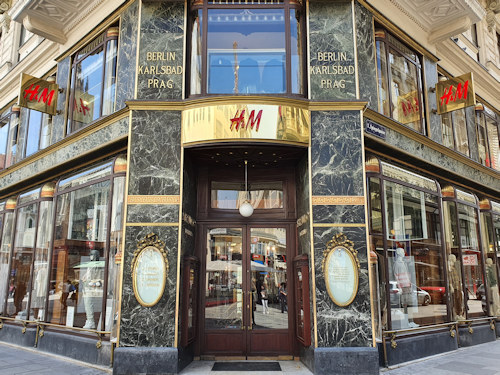
(An unexpected look for H&M)
No. 8 also makes a fine example of how a modern chain can still slip unobtrusively into historical surrounds: current occupants at the time of writing are H&M.
The name of the original business that commissioned the 1904 redesign can still be seen at the entrance. E. Braun & Co sold mainly clothing and luxury items in their long history. And it would not be Vienna without a musical connection. Alma Mahler (wife of Gustav) and Richard Strauss apparently shopped there.
At the end of the Graben, turn right to walk up Kärntner Straße for two famous locations.
Kärntner Straße
Look down the first road leading off to the right to find the Loos American Bar at Kärntner Durchgang 10.
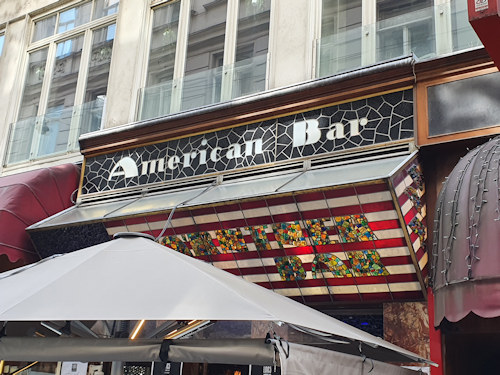
(The front mosaic spells out the words Kärntner Bar: the original name of the bar when it first opened)
Loos designed the interior and entrance portal in 1908, all of which has been restored and reconstructed in recent times.
You can see the insides on this old postcard:
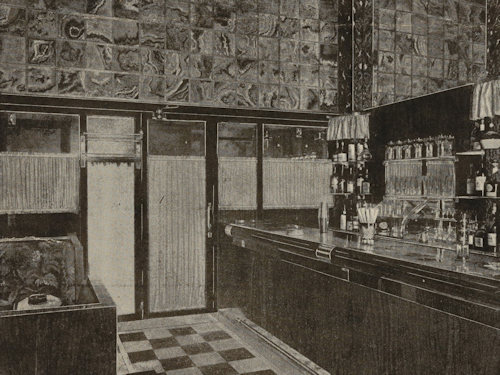
(Unknown photographer, Kärntner Durchgang/ Kärntner Straße 10 – “Kärntner Bar” (Loos-Bar), postcard, 1913, Wien Museum Inv.-Nr. 236088, excerpt reproduced with permission under the terms of the CC0 licence)
The “Loos bar” enjoys ongoing cult status through its tiny size, famous design, and a long list of celebrity patrons that has included the likes of Jolie and Jagger.
Further along Kärntner Straße is No.16:
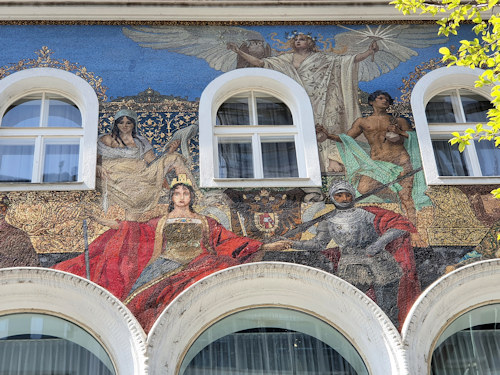
(Not all of the astonishing mosaic façade survived the deprivations of time, but much of it still remains)
And that completes our short tour.